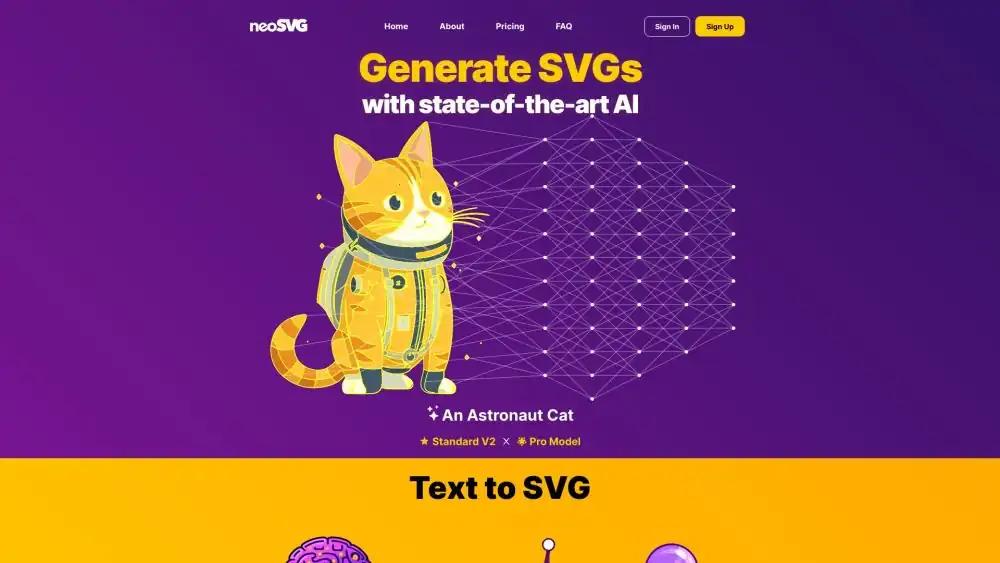Introduction to NeoSVG
NeoSVG is a JavaScript library designed to provide a flexible and efficient way to work with SVG (Scalable Vector Graphics) content in web applications. It offers a comprehensive set of features for creating, manipulating, and rendering SVG elements, making it a valuable tool for developers who want to incorporate vector graphics into their projects.
Key Features of NeoSVG:
- SVG DOM Manipulation: NeoSVG provides a high-level API for interacting with SVG DOM elements, allowing you to create, modify, and style SVG content programmatically.
- Rendering: NeoSVG can render SVG elements onto a canvas element, providing a smooth and performant rendering experience.
- Event Handling: The library supports event handling for SVG elements, enabling you to respond to user interactions such as clicks, mouse movements, and touch events.
- Animation: NeoSVG offers features for animating SVG elements, allowing you to create dynamic and interactive graphics.
- SVG Transformations: You can apply various transformations to SVG elements, including scaling, rotation, translation, and skewing.
- Accessibility: NeoSVG is designed with accessibility in mind, providing features to make SVG content accessible to users with disabilities.
Use Cases for NeoSVG:
- Data Visualization: Create interactive charts, graphs, and other data visualizations using SVG elements.
- Vector Graphics: Incorporate vector graphics into your web applications for scalable and high-quality visuals.
- Game Development: Use SVG for creating game assets, backgrounds, and user interfaces.
- Web Design: Enhance your web designs with custom SVG elements and animations.
Getting Started with NeoSVG:
- Include the NeoSVG library: Add the NeoSVG JavaScript file to your HTML page.
- Create an SVG element: Create an SVG element in your HTML document.
- Use the NeoSVG API: Access the SVG element using JavaScript and use the NeoSVG API to manipulate and render it.
By leveraging NeoSVG, you can create rich and interactive SVG-based content for your web applications, enhancing the user experience and adding visual appeal.
Pros and Cons of NeoSVG
Pros
- Scalability: SVGs, which NeoSVG manipulates, are vector graphics, meaning they can be scaled to any size without losing quality, making them ideal for responsive design and high-resolution displays.
- Flexibility: NeoSVG provides a comprehensive API for creating, modifying, and rendering SVG elements, offering great flexibility in designing and customizing graphics.
- Performance: SVGs are generally smaller in file size than raster images, leading to faster loading times and improved web performance.
- Interactivity: NeoSVG supports event handling and animations, allowing you to create dynamic and interactive SVG elements.
- Accessibility: SVGs can be made accessible to users with disabilities through proper implementation, and NeoSVG can help with this.
Cons
- Browser Compatibility: While SVG support is generally good in modern browsers, there might be minor compatibility issues or differences in rendering behavior between different browsers.
- Complexity: Working with SVGs and the NeoSVG API can be more complex than using simple raster images, especially for those new to vector graphics.
- Browser Support: Older browsers might have limited support for certain SVG features, which could affect your target audience.
Overall, NeoSVG offers a powerful and versatile tool for working with SVGs in web applications. While there are potential drawbacks, the benefits of scalability, flexibility, and performance make it a valuable choice for many developers.
Pricing for NeoSVG
NeoSVG is a free and open-source JavaScript library. This means you can use it without any licensing fees or costs. You can download and use the library freely for your projects.
Community Support and Commercial Use:
While the library itself is free, it’s important to note that community support and commercial use might have different considerations.
- Community Support: You can get support from the NeoSVG community through forums, online discussions, and GitHub issues.
- Commercial Use: If you’re using NeoSVG for commercial purposes, it’s recommended to review the specific terms and conditions of the license to ensure you’re complying with any requirements.
In summary, NeoSVG offers a cost-effective solution for working with SVGs in your web applications, as it’s freely available for download and use.
Alternatives to NeoSVG
Here are some popular alternatives to NeoSVG, along with their websites:
General-Purpose SVG Libraries
- Snap.svg: A powerful and flexible SVG library for creating and manipulating SVG elements. http://snapsvg.io/
- D3.js: A JavaScript library for manipulating documents based on data. It can be used to create interactive visualizations and charts using SVG. https://d3js.org/
- Raphaël: A JavaScript library for creating vector graphics on a web page. http://raphaeljs.com/
Specialized SVG Libraries
- SVG.js: A lightweight and modular SVG library focused on simplicity and performance. https://svgjs.dev/
- KonvaJS: A JavaScript library for drawing complex canvas and SVG shapes. It’s particularly well-suited for games and animations. https://konvajs.org/
- Fabric.js: A JavaScript canvas library that provides a rich set of features for creating and manipulating canvas objects, including SVG elements. http://fabricjs.com/articles/
Choosing the right alternative depends on your specific needs and preferences. Consider factors such as:
- Features: Does the library offer the specific features you require, such as animation, event handling, or transformations?
- Performance: How well does the library perform in terms of rendering speed and memory usage?
- Ease of use: Is the library easy to learn and use, especially if you’re new to SVG development?
- Community support: Does the library have a strong and active community that can provide help and support?
By carefully evaluating these factors, you can select the best alternative to NeoSVG for your project.
Frequently Asked Questions about NeoSVG
1. What is NeoSVG?
NeoSVG is a JavaScript library that provides a flexible and efficient way to work with SVG (Scalable Vector Graphics) content in web applications. It offers features for creating, manipulating, and rendering SVG elements.
2. Why should I use NeoSVG?
NeoSVG offers several advantages, including:
- Scalability: SVGs are vector-based, allowing them to be resized without losing quality.
- Flexibility: NeoSVG provides a comprehensive API for creating and manipulating SVG elements.
- Performance: SVGs can be smaller in file size than raster images, leading to faster loading times.
- Interactivity: NeoSVG supports event handling and animations for creating dynamic SVG content.
3. How do I get started with NeoSVG?
To get started with NeoSVG, you’ll need to include the NeoSVG library in your HTML file and create an SVG element. You can then use the NeoSVG API to manipulate and render the SVG content.
4. Can I use NeoSVG with other libraries or frameworks?
Yes, NeoSVG can be used with other JavaScript libraries and frameworks. It’s compatible with popular frameworks like React, Angular, and Vue.
5. Is NeoSVG free and open-source?
Yes, NeoSVG is a free and open-source JavaScript library. You can use it without any licensing fees or costs.
6. What are some common use cases for NeoSVG?
NeoSVG can be used for various purposes, including:
- Data visualization: Creating charts, graphs, and other data-driven visualizations.
- Vector graphics: Incorporating vector-based graphics into web applications.
- Game development: Creating game assets and user interfaces.
- Web design: Enhancing web designs with custom SVG elements and animations.
7. Are there any limitations or drawbacks to using NeoSVG?
While NeoSVG is a powerful tool, there are a few things to consider:
- Browser compatibility: Some older browsers might have limited support for SVG features.
- Complexity: Working with SVGs and the NeoSVG API can be more complex than using simple raster images.
8. What are some alternative libraries to NeoSVG?
Some popular alternatives to NeoSVG include:
- Snap.svg
- D3.js
- Raphaël
- SVG.js
- KonvaJS
- Fabric.js
9. Is there a community or support available for NeoSVG?
Yes, there is a community and support available for NeoSVG. You can find help and resources through online forums, documentation, and GitHub issues.
10. How do I contribute to the NeoSVG project?
If you’re interested in contributing to the NeoSVG project, you can report bugs, suggest features, or contribute code. You can find more information on the NeoSVG GitHub repository.
Conclusion
Here’s a general conclusion template you can adapt to your specific needs:
- Restate the thesis: Briefly restate the main point or argument you presented in your introduction.
- Summarize the key points: Briefly summarize the main supporting points or evidence you discussed in your body paragraphs.
- Offer a final thought: Provide a final thought or insight that connects your thesis to a broader context or offers a new perspective.
Example:
Thesis: The use of social media has both positive and negative effects on teenagers.
Conclusion:
In conclusion, social media has become an integral part of teenagers’ lives, offering both opportunities and challenges. While it can provide valuable connections and resources, it can also lead to negative consequences such as cyberbullying and addiction. It is crucial for teenagers to use social media responsibly and be aware of its potential risks. By understanding the both sides of social media, teenagers can harness its benefits while minimizing its drawbacks.
Would you like me to help you write a conclusion for a specific topic or essay? Please feel free to share more details about your work.
![]()






